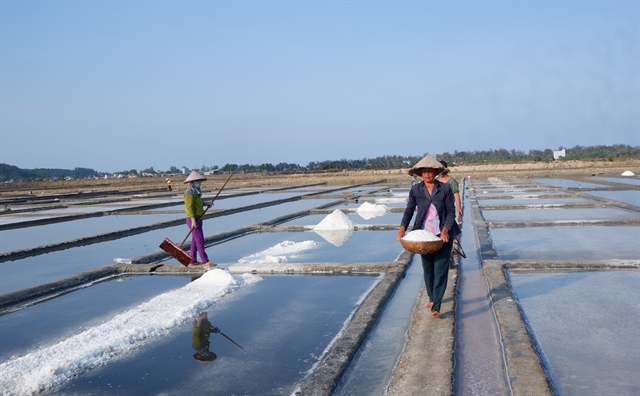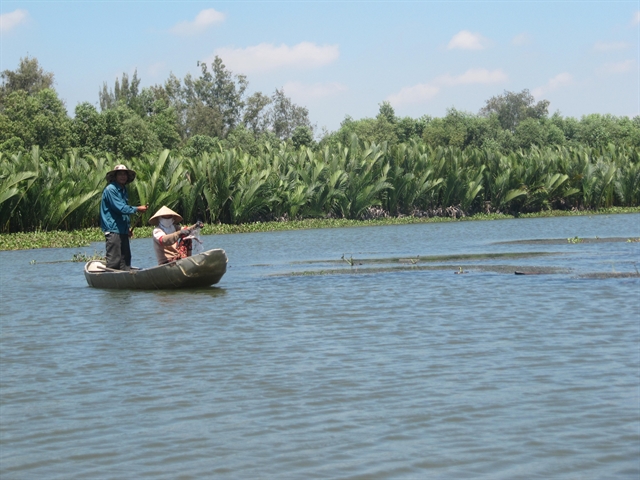 Environment
Environment


|
| An overview of Lý Sơn Island, off Quảng Ngãi Province coast. Despite being listed in the dossier for UNESCO recognition of the Lý Sơn-Sa Huỳnh Global Geo-Park, Quảng Ngãi Province plans to stop the project after years of preparation. — Photo courtesy of Bùi Thanh Trung |
QUẢNG NGÃI — Despite having prepared a dossier for the UNESCO recognition of the Lý Sơn-Sa Huỳnh Global Geo-Park last November, local authorities have shelved plans to apply for the park's recognition after years of efforts and some 160 field surveys and scientific seminars.
Chairman of the Quảng Ngãi provincial People’s Committee, Đặng Văn Minh, confirmed the province was ending the recognition efforts at a press conference on Wednesday, stating the park, which covers 4,600sq.km, would be used for various socio-economic development purposes.
He said the province had a working session with the Department of Culture, Sports and Tourism on the assessment of the park, and the provincial Party standing committee would give a decision on the halt of development activities related to the park later.
“Yet a final decision was made by the provincial Party standing committee and I personally agreed to stop the park development,” Minh said.
The province established the Lý Sơn-Sa Huỳnh Geopark in 2015 before preparing for global status recognition by UNESCO from 2017.
The Lý Sơn-Sa Huỳnh Global Geopark recognition was set to be decided upon by UNESCO at the general meeting in Jeju, South Korea last November, but the outbreak of the COVID-19 pandemic put paid to those plans, authorities said.
The province suspended all field activities on the park’s file completion process and scientific research in March last year.
“It’s a pity but it’s like that. So much work has been done and so many illusions were made. The suggestion is to create the UNESCO geopark obviously,” general secretary of the Global Geoparks Network and chairperson of the UNESCO Global Geoparks Council, Guy Martini, told Việt Nam News.

|
| Farmers collect salt in Sa Huỳnh salt field in Quảng Ngãi Province. The site has emerged as an eco-tour and community-based tourism in preservation of culture, history for sustainable development. — Photo courtesy of Sahu company |
“I have to say is that considering the huge investment already realised from 2017 by the Quảng Ngãi People’s Committee, thousands of working hours realised by the team, and more than 100 sites with already all the equipment designed (panels, parking, leaflets, posters, videos, etc) as well as the involvement of many local communities (for example, Gò Cỏ Village in Sa Huỳnh). Everything has been readied and already approved unofficially by UNESCO. The geopark project has to go on and get another UNESCO recognition for Việt Nam (and for this area),” Guy Martini said.
“There is a great misunderstanding from Quảng Ngãi People’s Committee of what is a UNESCO Geopark, which can't limit industrial zones or urban zones if these projects are legal and follow Vietnamese environmental legislation,” he added.
“Working with a UNESCO Geopark needs to ensure a dialogue to try to find the best compromise solution in function of the different interests in presence, but this dialogue has never existed with Quảng Ngãi People’s Committee,” he explained.
According to the management board of the Lý Sơn-Sa Huỳnh Geo-Park, the dossier was sent last November for official recognition by UNESCO, and an expert team was assigned to evaluate the value of the Lý Sơn-Sa Huỳnh Geo-Park, but the plan was delayed by the pandemic.
Many pieces of scientific and geological research on the Lý Sơn-Sa Huỳnh terrain and cultural value were reported at an international conference in 2019, contributing to the dossier before it was submitted to UNESCO.
Experts from the Việt Nam Institute of Geo-sciences and Mineral Resources said it takes five to seven years to complete a dossier for geopark recognition, and about seven parks in the world are approved by UNESCO each year.
Top Vietnamese archaeologists, geologists, volcano researchers and historians agreed that the Lý Sơn Islands, 30km off the coast of Quảng Ngãi Province, were formed by ancient volcanoes that existed more than 25 million years ago.

|
| Local fishermen go fishing in the wetland forest in Bình Sơn District of Quảng Ngãi Province. The site has rich biodiversity and is part of the Lý Sơn Sa Huỳnh Global Geopark previously seeking recognition by UNESCO. — VNS Photo Công Thành |
An area of 4,600sq.km, including more than 2,000sq.km of sea, covering nine districts and islands, was included in the area for global geopark recognition.
The recognition of Lý Sơn-Sa Huỳnh as a Global Geo-Park would have promoted the unique culture, rich biodiversity and extinct volcanoes around Lý Sơn Islands.
Việt Nam has three global geoparks recognised by UNESCO – Đồng Văn Karst Plateau in the northern province of Hà Giang (in 2010), Cao Bằng Geopark (2018) and Đắk Nông Geopark in 2020. — VNS




